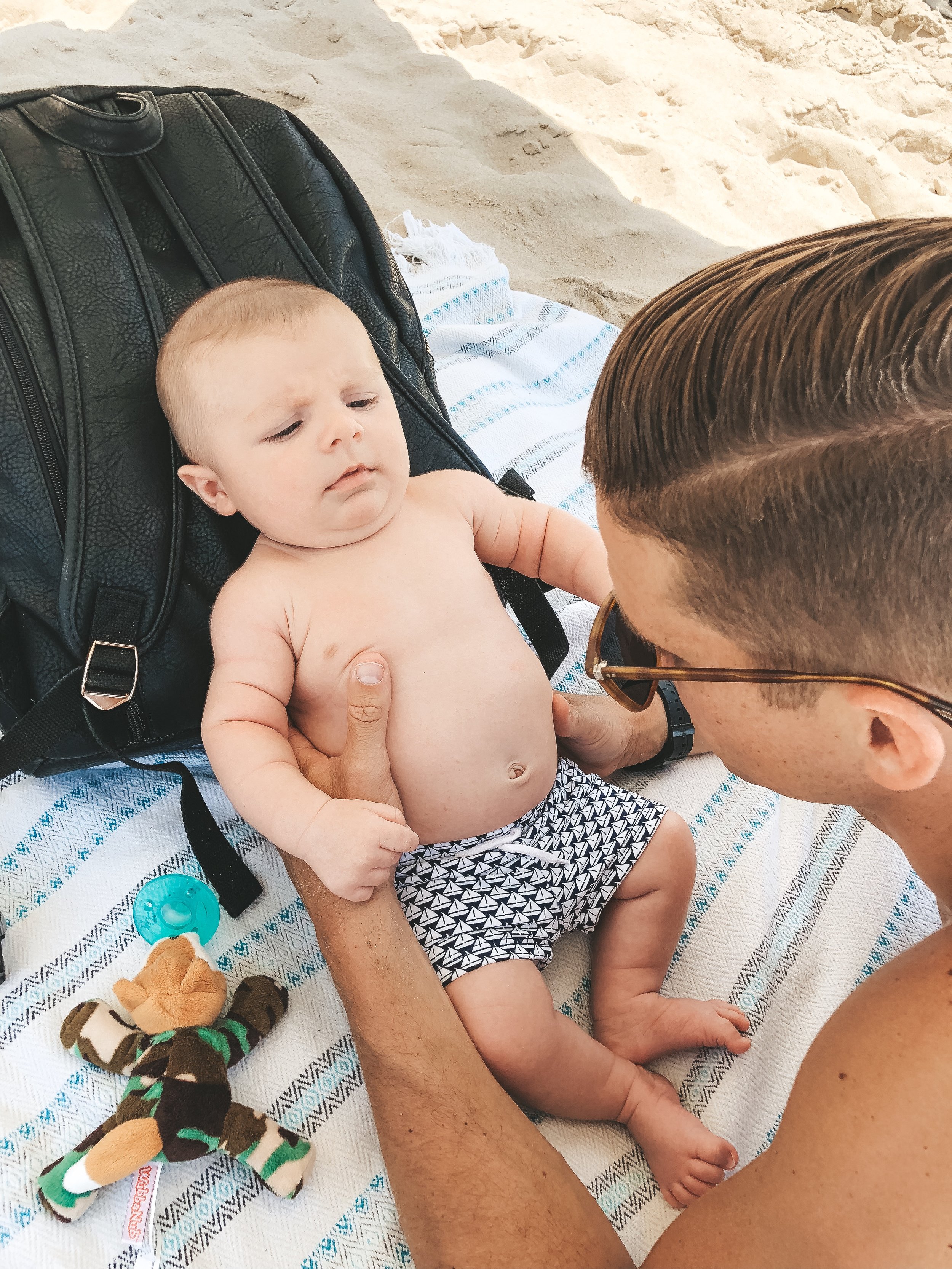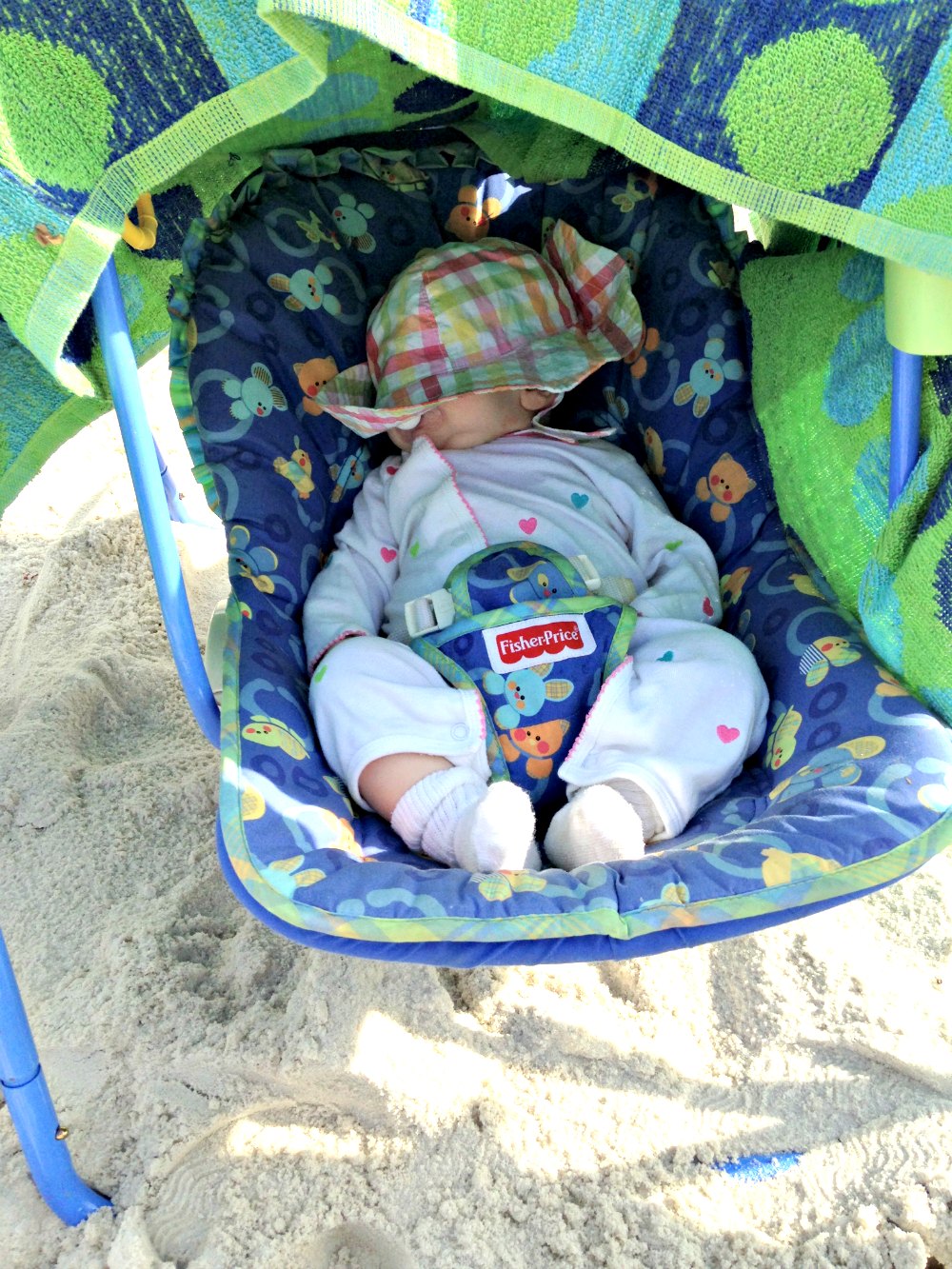You can take a baby to the beach once they are six months old. At this age, they can handle the environment better and enjoy the sights and sounds.
It’s important to prioritize safety and comfort for your little one. Visiting the beach with your baby can be a delightful experience. Imagine the first time they feel the sand between their tiny fingers. Or the gentle breeze on their cheeks.
But before packing your beach bag, there are essential things to consider. Babies have sensitive skin and need extra protection from the sun. The beach can be overwhelming with sounds and sights. Planning ahead ensures a fun and safe outing. Understanding when and how to take your baby to the beach can help create lasting memories. Let’s explore the best practices for a stress-free beach day with your baby.

Credit: www.me-and-mrjones.com
Ideal Age For Beach Trips
Taking a baby to the beach is safe when they are around six months old. Babies need protection from the sun. Always bring shade and sunscreen to keep them safe.
### Ideal Age for Beach TripsTaking your baby to the beach is an exciting adventure. It’s a chance for them to experience the wonders of nature. But you might wonder when’s the best time to start.Timing is crucial to ensure a safe and enjoyable trip. Consider your child’s age and development stage. Each phase comes with unique needs and challenges.### Newborn ConsiderationsNewborns have delicate skin. Their tiny bodies need protection from the sun’s harsh rays. It’s wise to wait until they’re a bit older before planning a beach day.Babies under six months should stay out of direct sunlight. You can enjoy the beach by keeping them under a shaded area. Bring a portable tent or umbrella for extra protection.Think about the noise and crowds. Newborns can be sensitive to loud environments. Choose a quieter beach or visit during off-peak hours.### Toddler Beach AdventuresToddlers are little explorers. They’re curious and eager to interact with their surroundings. This age is ideal for introducing them to the beach.Pack toys to keep them entertained. Buckets and spades are perfect for building sandcastles. Their excitement is infectious.Safety is a priority. Toddlers can wander off quickly. Always keep a close eye on them, especially near the water.Consider their routine. Toddlers thrive on consistency. Plan your beach trip around nap times to avoid crankiness.What activities will make your toddler’s beach day memorable? Share your thoughts in the comments!Health And Safety Precautions
Taking a baby to the beach can be a wonderful experience. The sound of waves and the feel of sand can be soothing. But parents must prioritize health and safety precautions. A baby’s skin and body are sensitive. They require special care against sun and heat. Ensuring your little one’s safety at the beach is crucial.
Sun Protection Essentials
A baby’s skin is very delicate. Use a broad-spectrum sunscreen suitable for infants. Apply it generously before heading out. Reapply every two hours, especially after swimming. Dress your baby in a wide-brimmed hat. Choose lightweight, long-sleeved clothing for added protection. Seek shade during peak sun hours. Carry an umbrella or sun tent for extra coverage.
Hydration And Nutrition
Babies can get dehydrated quickly in the sun. Offer water frequently to keep them hydrated. For infants under six months, breast milk or formula is essential. Pack snacks like fruit purees for older babies. Avoid sugary drinks; they don’t hydrate well. Keep food cool and fresh in an insulated bag. Monitor for signs of dehydration, like dry lips or lethargy.
Packing For The Beach
Babies can visit the beach after six months. Ensure they wear sun-protective clothing and hats. Bring enough sunscreen and keep them hydrated.
Packing for the beach with a baby can feel like a daunting task, but it doesn’t have to be overwhelming. With a little preparation and the right gear, you can ensure a smooth and enjoyable beach day for your little one and yourself. Imagine the gentle breeze, the sound of waves, and your baby giggling with delight as they experience the beach for the first time.Essential Gear Checklist
Before you hit the sand, make a checklist of essential items to bring along. A sturdy beach umbrella or sunshade is crucial to protect your baby from the sun’s rays. Don’t forget a large blanket or beach mat to provide a clean, comfortable spot for playing and resting.You’ll also need a diaper bag packed with all the essentials. Include plenty of diapers, wipes, and a changing pad. A small cooler with snacks and formula or breast milk can keep your baby satisfied throughout the day.Comfortable Clothing Choices
Dress your baby in lightweight, breathable clothing to keep them cool. A wide-brimmed hat is a must to shield their delicate skin from the sun. Choose swimwear with UV protection for added safety.Consider bringing an extra set of clothes for your baby. Sand and water can quickly make clothes uncomfortable, so having a dry outfit handy can save the day. Have you thought about how quickly the temperature can change at the beach? A light hoodie or sweater might be needed as the sun starts to set.By planning ahead and packing thoughtfully, you can transform a day at the beach with your baby from stressful to delightful. What are your must-have items for a successful beach trip with your little one?
Credit: refiningthechaos.com
Beach Activities For Babies
Taking your baby to the beach can be an exciting adventure. It’s not just about soaking up the sun; it’s a chance for your little one to explore new sensations and experiences. Beach activities for babies can be a wonderful way to bond and create lasting memories. But what can you do to make the most of your beach day with your baby?
Sensory Play Ideas
Think of the beach as a giant sensory playground. The sand, water, and breeze offer endless opportunities for sensory play. Let your baby feel the sand between their fingers and toes. You might be amazed at their curiosity and delight.
Bring along a small bucket and shovel. Encourage your baby to scoop and pour sand. This simple activity helps them understand textures and develop fine motor skills.
Don’t forget the water! Let your baby splash in the shallows. The cool water on their skin is refreshing and stimulates their senses. Just be sure to keep a close eye on them for safety.
Interactive Games
Interactive games are perfect for engaging your baby at the beach. A simple game of peek-a-boo behind a beach towel can spark giggles and smiles.
Play a game of “find the seashell.” Hide a small shell in the sand and let your baby search for it. This game encourages curiosity and discovery.
Consider singing songs or nursery rhymes. The rhythmic sounds of the waves can be a soothing backdrop. Your baby may even join in with their own babbling.
As you enjoy these activities, think about how they impact your baby’s development. How do these experiences contribute to their growth and curiosity? Beach days are more than just fun—they’re a chance to nurture your baby’s budding interests.
Managing Naptime At The Beach
Taking a baby to the beach requires planning. Babies can visit the beach after six months. Ensure shade and sun protection for a safe naptime.
Taking your baby to the beach for the first time is an exciting adventure. However, managing naptime can be a challenge amidst the sun, sand, and waves. Creating a comfortable and familiar environment for your little one to rest can make all the difference. With a bit of planning, you can ensure your baby enjoys a peaceful nap while you soak up the sun. Let’s delve into some practical tips to make naptime at the beach a breeze.###Creating A Cozy Nap Environment
A cozy nap environment at the beach requires a bit of creativity. A pop-up beach tent can serve as a mini sanctuary, shielding your baby from the sun and wind. Look for one with adequate ventilation to keep the interior cool.Bring along a favorite blanket or a soft beach towel for added comfort. A familiar scent can make the space more inviting. You might also consider a portable white noise machine to drown out beach sounds and help your baby drift off.###Timing Naps With Beach Schedule
Timing is everything when balancing beach fun and nap schedules. Consider your baby’s usual nap times and plan your beach visit accordingly. Arriving in the morning might coincide with your baby’s first nap, allowing them to rest before the peak sun hours.Observe your baby’s cues and be flexible. If you notice signs of tiredness, create a quiet moment and encourage them to rest. This way, you can enjoy more of the day once they’re refreshed.Are there any tricks you’ve discovered to make beach naptime easier? Share your experiences in the comments.Handling Emergencies
Taking a baby to the beach can be joyful and exciting. Yet, handling emergencies is crucial for a safe experience. Being prepared can help you manage unforeseen events with ease. Proper planning ensures a relaxed day under the sun. Let’s explore essential tips for handling emergencies at the beach.
First Aid Kit Must-haves
A well-stocked first aid kit is a beach necessity. Include band-aids and antiseptic wipes for cuts and scrapes. Carry a small bottle of saline for eye irritations. Pack a digital thermometer for quick temperature checks. Add a pair of tweezers for removing splinters. A small tube of hydrocortisone cream can soothe bug bites. Remember, a first aid kit can make a big difference.
Dealing With Unexpected Weather
Weather can change quickly at the beach. Always check the forecast before heading out. Pack a light blanket to shield from sudden winds. Carry an umbrella to provide shade or shelter from unexpected rain. Keep a set of dry clothes in the car. A waterproof bag can protect your belongings from rain or splashes. Having these items helps manage weather surprises smoothly.
Choosing The Right Beach
Choosing the right beach for your baby is important. Different beaches offer different experiences. Some are more suitable for families. When planning your first beach day with your baby, consider factors like safety, comfort, and convenience. Look for places that cater to families and have essential amenities.
Family-friendly Locations
Family-friendly beaches are perfect for babies. They often have gentle waves and soft sand. These beaches tend to be quieter. This means fewer disturbances for your baby. Look for beaches with shallow waters. Babies can splash safely in these areas. Parks nearby add value. They provide extra space for play. Research online to find popular family beaches. Reviews often highlight their suitability for young children.
Amenities To Look For
Amenities make a beach trip easier. Restrooms are vital for quick diaper changes. Shade structures protect your baby from sunburns. Look for beaches with lifeguards. Their presence ensures safety. Picnic areas are useful for feeding times. Access to fresh water is important. You’ll need it for cleaning and hydration. Parking close to the beach is ideal. It reduces the hassle of carrying baby gear.
Expert Advice From Pediatricians
Pediatricians suggest waiting until a baby is at least six months old before heading to the beach. Babies need protection from sun and sand. Lightweight clothing and hats help shield delicate skin from harmful rays.
Taking your baby to the beach for the first time can be both exciting and nerve-wracking. Many parents wonder when the right time is to introduce their little one to sun, sand, and sea. Thankfully, pediatricians offer valuable insights that can guide you in making this memorable experience safe and enjoyable for your baby. By understanding the common concerns and following personalized advice, you can feel confident that your baby’s first beach day will be a success.Common Concerns And Solutions
Pediatricians often hear from parents worried about sun exposure for their babies. Babies have sensitive skin and can burn easily, even on cloudy days. Use a broad-spectrum sunscreen with an SPF of at least 30, and reapply every two hours. Dressing your baby in lightweight, long-sleeved clothing and a wide-brimmed hat can provide added protection.Another common concern is overheating. Babies can’t regulate their body temperature as well as adults. Ensure your baby stays cool by bringing a beach umbrella or a pop-up tent for shade. Offer plenty of fluids, and watch for signs of discomfort or redness.Sand can also be a worry. Babies are naturally curious and may try to taste it. To prevent this, bring along a clean blanket or playpen to create a safe, sand-free zone where they can explore. Regularly check their hands and face to make sure they’re free of sand.Personalized Tips For Your Baby
Every baby is different, and what works for one might not work for another. Consider your baby’s personality and needs when planning your beach outing. If your baby is sensitive to noise, choose a quiet time of day to visit the beach. Early morning or late afternoon are usually less crowded and cooler.Your baby’s routine matters too. Stick to their usual nap and feeding schedules as much as possible. A well-rested and fed baby is a happy beachgoer. Bring familiar toys or comfort items to make the new environment feel less daunting.Think about how your baby reacts to new textures. Some babies love the feel of sand between their toes, while others might be unsure. Introduce them to the sand gradually, perhaps by letting them feel it with their hands before sitting on it. Watching their reactions can guide you in making the experience more enjoyable.Have you ever thought about how your baby perceives the beach? Observing their reactions can offer insights into their personality and preferences. Embrace these moments, as they are opportunities to learn more about your baby while making unforgettable memories.
Credit: northshoreparent.com
Frequently Asked Questions
Can I Take My 2 Month Old To The Beach?
Yes, you can take your 2-month-old to the beach. Ensure they are protected from the sun with shade, appropriate clothing, and sunscreen for infants. Keep them hydrated and monitor them closely for any signs of discomfort. Short visits are best to avoid overexposure.
What Age Can Babies Go In Sand?
Babies can play in sand once they can sit up independently, usually around 6 months old. Always supervise to ensure safety. Sand play aids sensory development and is enjoyable for babies. Choose clean, safe environments for sand play to prevent health risks.
How Old Should A Newborn Be Before Going To The Beach?
Newborns can visit the beach after two months, but always consult a pediatrician first. Keep them shaded and hydrated. Limit sun exposure to protect their sensitive skin. Always use baby-safe sunscreen and protective clothing. Ensure they’re comfortable and happy during the visit.
Can A 3 Month Old Go In The Ocean?
It’s generally not recommended to take a 3-month-old into the ocean. Their skin is sensitive, and they can’t regulate body temperature well. Consult your pediatrician before any water activities. Always prioritize the baby’s safety and comfort.
What Is The Best Age To Take A Baby To The Beach?
Babies can enjoy the beach after six months. Ensure they have sun protection.
Conclusion
Taking a baby to the beach can be a joyful experience. Ensure your little one is ready for the adventure. Consider their age and health. Pack essentials like sunscreen, hats, and snacks. Always supervise and stay close to them. Choose a safe, family-friendly beach.
Watch for signs of discomfort or fatigue. Take breaks in the shade. Enjoy the moments, but prioritize safety. A little planning ensures a fun day by the sea. Your baby will love the sounds and sights. Happy beach outing!





